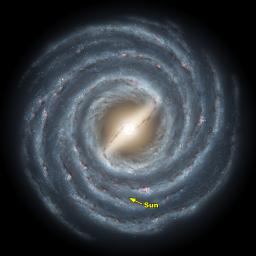Astronomy 1101 --- Planets to Cosmos
Todd Thompson
Department of Astronomy
The Ohio State University
The Milky Way and Distances
- The Milky Way is our Galaxy
- Diffuse band of light crossing the sky
- Galileo: Milky Way consists of many faint stars
- The Nature of the Milky Way
- Philosophical Speculations: Wright & Kant
- Star Counts: Herschels & Kapteyn
- Globular Cluster Distribution: Shapley
- Geometric Distances: Parallax
- Luminosity Distances
- "Standard Candles"
- RR Lyrae Variables
- Cepheid Variables
The Milky Way
Diffuse band of light crossing the night sky.
All human cultures have named it:
- a Celestial River
- a Celestial Road or Path
Our words "Galaxy" and "Milky Way" are derived from Greek
and Latin:
- Greek: Galaxias kuklos = "Milky Band"
- Latin: Via Lactea = "Road of Milk"
"The Starry Messenger"
Galileo (1610):
- Galileo observed the Milky Way with his new telescope.
- Published his findings in his pamphlet, Siderius Nuncius
(The Starry Messenger)
- "For the Galaxy is nothing else than a congeries of innumerable
stars distributed in clusters."
This was the first observation that showed that the Milky Way was simply
made of many many unresolved faint stars.
Philosophical Interlude
Thomas Wright (1750):
- Picture motivated by theological considerations
- Wright made no new observations.
Model:
- Milky Way is a thin spherical shell of stars.
- The Sun is located inside the shell about midway between the
inner and outer edges.
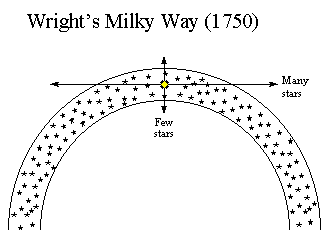
- [Section of Wright's original woodcut]
(Graphic by R. Pogge)
From our location near the Sun:
- Looking along the shell: See a broad band of stars ("Milky Way")
- Look out along the thin part of the shell: See few stars
A Theory of the Heavens
Immanuel Kant (1755):
- Misread a newspaper account of Wright's model.
- Also made no observations of his own.
Model:
- Lens-shaped disk of stars rotating about its center.
- No special place for the Sun.
- Other "nebulae" are distant, rotating milky ways
like ours.
Later became known as the "Island Universe" Hypothesis
(term coined by Alexander von Humboldt, Kosmos, 1845).
The Herschels' Star Gauges
William & Caroline Herschel (1785):
- Counted stars along 683 lines of sight using their 48-inch
telescope.
- Assumed that all stars are the same luminosity, so the relative
brightness give relative distance.
- Assumed that they could see all the way to the edges of the system.
Model:
- Flattened Milky Way ("grindstone")
- Sun located very near the center.
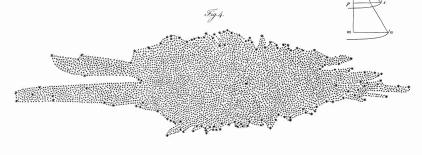
- The Milky Way Map of William Herschel. Click to
see a larger version.
Figure 4 from On the Construction of the Heavens by
William Herschel, published in Philosophical Transactions of the Royal
Society of London, Vol. 75 (1785), pp. 213-266. Image scanned
by the author.
The Kapteyn Universe
Jacobus Kapteyn (1901 thru 1922):
- Used photographic star counts
- Estimated distances statistically based on parallaxes &
proper motions of nearby stars.
- Neglected interstellar absorption of starlight (assumes that
stars were faint only because they far away, not because interstellar
absorption blocks some of the light).
Model:
- Milky Way is a flattened disk ~15 kpc across & ~3 kpc thick
- The Sun is located slightly off-center.
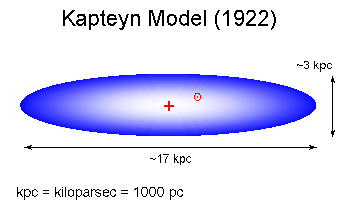
- Sketch based on Kapteyn's paper.
(Graphic by R. Pogge)
Harlow Shapley (1915 thru 1921)
Astronomer at the Harvard College Observatory who was working
on the nature of Globular Clusters of Stars.
Shapley noted two facts about Globular Clusters:
- They were uniformly located above & below the Milky Way.
- They were concentrated on the sky toward Sagittarius.
Observations:
- Estimated Globular Cluster distances from observations of their
RR Lyrae stars
- Used these distances to map the globular cluster distribution in space.
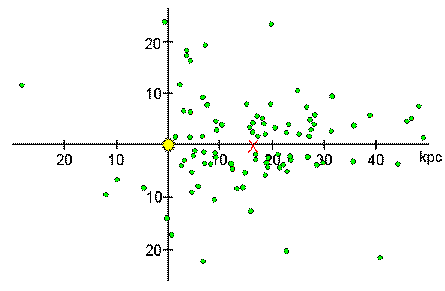
- Sketch based on Shapley's original data, uncorrected for interstellar
absorption. The Sun is located at the center of the axes
(looking roughly side-on), and the center of the Milky Way inferred
by Shapley is marked by the red X.
(Graphic by R. Pogge)
The Greater Milky Way
Shapley's Results (1921):
- Globular clusters form a subsystem centered on the Milky Way.
- The Sun is 16 kpc from the MW center.
- MW is a flattened disk ~100 kpc across
Right basic result, but too big:
- Shapley ignored interstellar absorption
- Caused him to overestimate the distances.
The Problem of Absorption
Absorption of Starlight by Interstellar Dust:
- Interstellar space is filled with gas and dust
- This dust absorbs and scatters starlight passing through it,
- This makes more distant objects look fainter than they
otherwise would be if there were no interstellar dust.
- If left unaccounted for, it can lead to serious
overestimates of
Luminosity Distances.
Absorption by Interstellar Dust affects all attempts to map the Milky Way:
- Shapley & Kapteyn thought it was smaller than it actually
is, and so overestimated the size of the Milky Way.
- Robert Trumpler (1930) showed that interstellar dust absorption
was significant.
The Milky Way
Our present view of the Milky Way today is largely Shapley's model, but
corrected for the effects of interstellar absorption:
The Distance Problem
Measuring accurate distances remains the biggest technical problem in
Astronomy.
Distances are necessary for estimating:
- The total energy released by objects (Luminosity)
- The physical sizes of objects
- The masses of objects
- The distribution of objects in space
Geometric Distances
Direct measurements of distances using geometry.
Stellar Distances:
- Method of Trigonometric Parallax
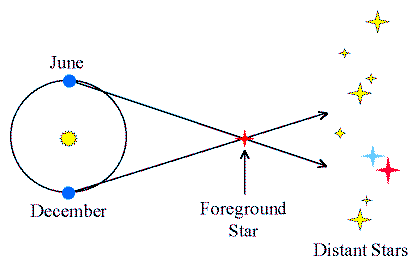
(Click on the image to view at full scale [Size: 7Kb])
(Graphic by R. Pogge)
Parallax Limits
Ground-based parallaxes are measured to ~0.01-arcsec
- good distances out to 100 pc
- < 1000 stars this close
Hipparcos satellite measures parallaxes to ~0.001-arcsec
- good distances out to 1000 pc
- ~100,000 stars
Indirect distance estimate:
- Measure the object's Apparent Brightness, B
- Assume the object's Luminosity, L
- Solve for the object's Luminosity Distance, dL,
by applying the Inverse Square Law of
Brightness

(Graphic by R. Pogge)
We call this the Luminosity Distance (dL) to distinguish
it from distances estimated by other means (e.g. geometric distances from
parallaxes).
The only observable is the object's Apparent Brightness, B. The
missing piece is the luminosity, (L), which must be inferred in some
way.
Any object whose Luminosity you know ahead of time ("a priori")
is known as a Standard Candle.
The way you establish that a class of objects is a standard candle is
via a multi-step calibration procedure known as the "Bootstrap Method".
Bootstrap Method:
- Calibrate the Luminosities of nearby objects for which
you have a Trigonometric Parallax distance.
- Identify distant but similar objects, using a
distance-independent property that they share.
- Assume that the distant objects have the same Luminosity
as the nearby objects for which you have distances.
Once you have a calibration of a set of standard candles, you can then
apply them to measuring distances to objects that are too far away for
geometric methods like parallaxes.
Periodic Variable Stars
Stars whose brightness varies regularly with a characteristic, periodic
(repeating) pattern.
Distance-Independent Property:
- Period (repetition time) of their cycle of brightness variations.
Physics:
- Period-Luminosity Relations exist for certain classes
of periodic variable stars.
- Measuring the Period gives the Luminosity.
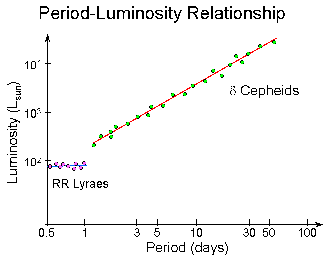
(Graphic by R. Pogge)
Rhythmically pulsating Horizontal-Branch stars:
- Found in old clusters, Galactic bulge & halo
- Luminosity of ~50 Lsun
- Brightness Range: factor of ~ 2-3
- Period Range: few hours to ~ 1 day.
- Relatives of Cepheid Variables
Period-Luminosity Relation:
- Less strong than for Cepheids
Method:
- Same as for Cepheids, but using the RR Lyrae P-L Relation to
get an estimate of the Luminosity.
Distance Limit:
- ~1 Megaparsec (Hubble)
- Limited to our Galaxy & Andromeda
Problems:
- No RR Lyrae stars with precision parallaxes
- RR Lyrae stars are fainter than Cepheids, so they are only
useful as standard candles relatively nearby.
Class of rhythmically pulsating Supergiant stars:
- Found in young star clusters
- Luminosity of ~ 103-4 Lsun
- Brightness Range: few percent to a factor 2-3 in brightness
- Period Range: 1 day up to ~50 days.
Period-Luminosity Relation:
- Longer Period = Higher Luminosity
- P = 3 days, L ~ 103 Lsun
- P = 30 days, L ~ 104 Lsun
Method:
- Measure the pulsation period (P)
- Using the P-L relation, read off the Luminosity (L)
- Compute the Luminosity Distance (dL) from the
Apparent Brightness and inferred Luminosity.
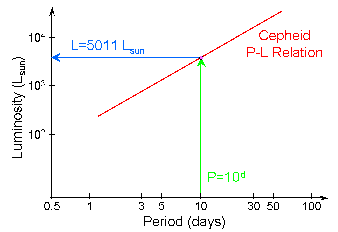
(Graphic by R. Pogge)
Distance Limit:
- 30-40 Megaparsecs (Hubble Space Telescope)
- Crucial for measuring distances to galaxies.
Problems:
- No Cepheids with precise parallaxes (a few now have low-quality
parallaxes measured by Hipparcos, but are just at the edge of
what Hipparcos can do).
- Two types of Cepheids with different P-L relations (delta Cephei and
W Virginis stars, respectively).
Despite the limitations and problems, Cepheid Variable Stars
(specifically delta Cephei stars) are one of the most important Standard
Candles we use to measure cosmic distances.
The Cosmic Distance Scale
No single method will provide distances on all cosmic scales. Instead,
we have to rely on a multi-step approach that is carefully calibrated
at each step.
This makes the Cosmic Distance Scale look like a ladder with a series of
steps going from near to far:
- Calibrate Parallaxes using the Astronomical Unit (orbit of the Earth)
- Calibrate H-R diagram methods using stars with measured Parallaxes.
- Calibrate Cepheid and RR Lyrae star distances using H-R diagrams.
Inaccuracy and imprecision at each step carries forward into the next,
making each subsequent step less accurate.
Part of the challenge is to understand the sources of these inaccuracies
and taking them into account.
Updated/modified 2014, Todd Thompson
Copyright Richard W. Pogge,
All Rights Reserved.






